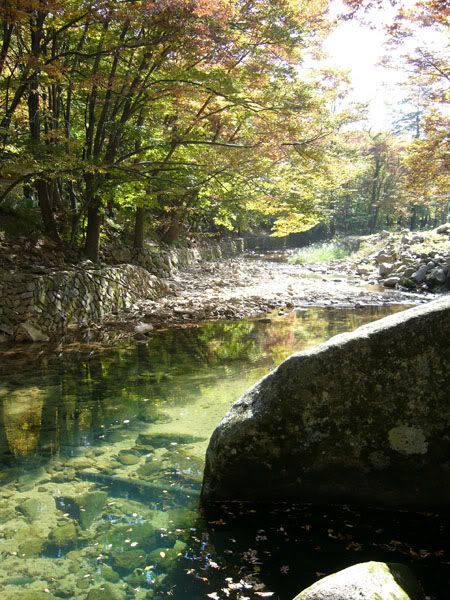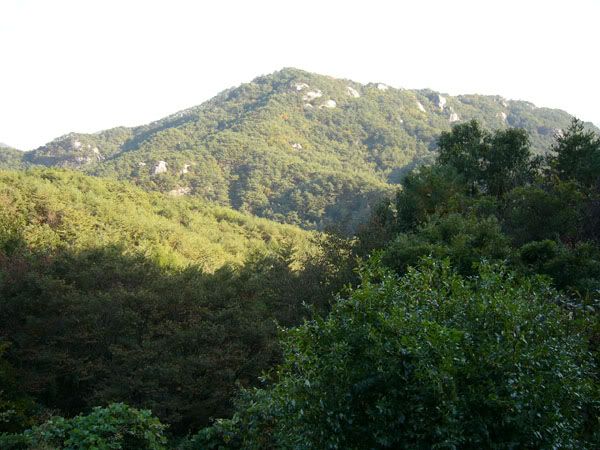So last weekend was our first non-Seoul-related experience with Korea outside of Cheongju by ourselves.
Shut up! It was a big step!
Anyway, we went to a national park near us called Songnisan. It's about a 90 minute bus ride away, and due to the wonderfully cheap transportation here, only cost us 5600won each, one-way.
This trip showed us a couple things:
1)It's interesting to be in a place where Buddhism is an actual religion, rather than mostly just a fad.
2) Korea can actually be a beautiful country, once you get away from the relatively dirty, crowded and noisy cities:

3) Buddha is always *HUGE*
Seriously:


The latter is a relief of Buddha carved into the side of a huge rock. The former is sortof the main attraction of Songnisan, but before I'll get into details in a second. I found it odd that we paid admission to get in to this park (a meagre 8000won each, but still) when it is a fully-functional place of worship for Buddhists in Korea. All the pagodas surrounding the huge Buddha statue had other smaller (but still enormous in their own right) statues, and places for people to light incense/candles and mats for prostrating yourself in prayer. I just wonder how the pilgrims feel about being charged upon entry. Anyway, that's neither here nor there. Well, technically, it's a lot closer to here, if here is where I'm writing, and there is where most of you are reading, but that's irrelevant too.
So, about that huge statue...
It's apparently the second biggest statue of Buddha in Korea, and I swear it wasn't Maxwell Smart who told me. It's 33m high. Until a couple years ago, it was made of bronze, having been completed in this most recent incarnation (GET IT? HAH!!!) in 1994. In 2002 it was covered in solid gold. For some very peculiar reasons....

Does anyone else find at least one of those reasons a bit out of place? I mean, it's tenuous at best to link world peace with laying over 160 pounds of solid gold onto a 33 metre Buddha statue, but "to commemorate the successful organization of the 2002 World Cup"? I don't know much about the specifics of "guardian Buddhism", but I'd be willing to hazard a guess that whatever's involved in its "inheritance" may have actually been the driving reason behind this little endeavour, and the rest are just "Miss America"-style filler reasons, but that may be just me.
In addition to the statue and carvings, there were a bunch of pagodas around, like this one:

...which is the tallest one in Korea. All of them were incredibly beautiful in design, inside and out, but we were informed in no uncertain terms (and without the slightest use of English) that taking pictures inside was a definite no-no. In fact, at the doorway to the above temple, the fact that I pointed to my camera with an inquiring look at an elderly Korean custodian was enough to convince her that at any moment, I was about to completely surrender myself to a veritable orgy of sacriligious shutter-happiness, and needed to be physically shooed away from the pagoda as rapidly as possible. The whole thing was quite amusing. I kept the camera hidden while exploring the inside of the other pagodas (which I was completely free to do).
The temple complex was imressive and everything, but was still only the second coolest thing we saw that day. As you may imagine, a national park (even in a country the size of Korea) encompasses a larger area that just a few pagodas and an enormous gold statue. There are several mountains to climb - with peaks all around the 1000m-high mark - and temples and neat things to see scattered all over the place. One of these was a little path where you could walk barefoot on little pebbles of yellow ocher, which is believed to be able to relieve symptoms of any number of things, including things that we weren't even aware were diseases.

The coolest thing that we saw was also the last before heading home that afternoon. On a big tourist map billboard across the street from the main bus station, there were marked all the main hiking paths up the mountain, to Bopjusa (the name of the temple complex with the huge statue) and around the little village. It also had temples and rest areas marked with little icons.
A bit away from everything else were two temple-esque icons with no marked paths leading to them, and not much in the way of labels. We thought it'd be fun to try to track one of them down. We were also thinking that there would be fewer people around, so it would make for a quieter time. Right on both counts.
We walked down a road that seemed to be heading in the general direction of the closest temple-thing. Keep in mind that apart from the big billboard thing, the maps didn't have these spots listed. After a while on that little road, we notice the village dwindling into widely spaced, more rural-looking dwellings, and finally just into fields of various crops. Then the road itself dwindled into a concrete bath just barely wider than one vehicle. After about 15-20 minutes walking down that path, there was a branch leading off towards the forested mountain, which was just dirt track. We followed that for about 15 minutes, now starting up the mountain, until it ended in a little cul-de-sac. Off from the cul-de-sac was a barely-cleared forest trail, marked by a string of paper lanterns hung through the trees. This was mostly where it started to get cool. The only person we had seen since the village started dwindling away was an old man sitting by the side of the dirt path with a little cart full of sticks and a little saw, smoking away at a pipe. He smiled and waved as we walked past.
So, we started climbing the path through the woods. This'll give you an idea of what the path was like:

Yeah, you see that little blue paper lantern. That's the trail marker. Anyway, we climbed that path for about 30 minutes and finally reached a tiny hermitage, completely nestled up on the side of this mountain. This is the view the hermits have:

It was amazingly quiet and really quite awe-inspiring to think that people actually live there, totally cut off from everything and everyone, just hanging out on the side of their mountain. I think anyone who lives that far into the wilderness deserves to call it "their mountain."
There was a building that was apparently the living quarters, a small garden, and a little temple area, much less ornate than the ones at the tourist centre:

Anyway, that was one of the coolest things we've seen so far. We decided to save the actual mountain climb, which takes approx 3 hours on the way up and 2 on the way down (probably significantly less if you're not picky about your physical well-being upon arrival at the base), for another visit where we can come early and take our time enjoying the scenery.
Is it unusual for me to have had the M*A*S*H theme song stuck in my head intermittently for the past 6 weeks?